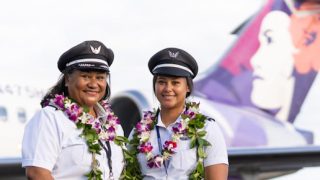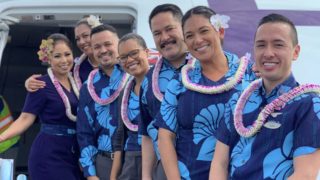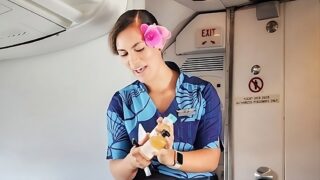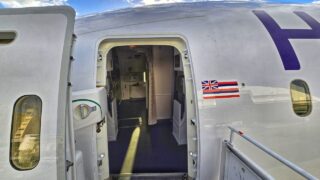Alaska’s rapid 2026 integration timeline is running straight into three labor battles that each carry real consequences for Hawaii travelers. The most immediate flashpoint sits inside the maintenance hangars. About 900 Hawaiian mechanics represented by IAM since 1951 are facing a representation challenge from AMFA, which speaks on behalf of roughly 1,000 Alaska mechanics, even though Alaska’s fleet is nearly three times larger.
At the same time, as many as 40 to 60 line service workers sit in limbo and worry their jobs could disappear depending on how the vote breaks. The numbers alone explain why this suddenly feels like a high stakes moment. A roughly $28,000 annual pay gap separates the top scales at the two airlines.
Most work for the 717 interisland fleet will remain in Hawaii as long as those aircraft continue to fly, but the fleet’s future is likely limited to about five years. When the 717s retire, they will leave the operation entirely, and the maintenance work tied to that fleet will disappear with them. All of this is happening as Alaska moves ahead with its recently issued single operating certificate and a newly combined passenger service (reservation) system cutover planned for early 2026.
Travelers may not feel these issues directly today, but the decisions made over the next year will shape how travelers experience the airlines long after the paint schemes and brand promises settle.
What does this mean for Hawaii travelers?
For people heading to and from Hawaii, the most immediate concern is how maintenance decisions made during the integration could change the way aircraft are supported for Hawaii flying. Hawaii based mechanics have decades of experience working in this unique operating environment, with its long overwater routes and weather conditions that are different from mainland patterns. If more heavy work eventually shifts to mainland bases, the distance alone could affect how quickly aircraft return to service when something unexpected happens, and that is where travelers could feel it.
There is also the interisland question mentioned above, and what happens after the 717 fleet reaches the end. Whether that flying is taken over by new narrowbody aircraft, contracted regional partners, or a hybrid arrangement will affect fares, frequency, and the number of nonstop options available. That decision will also shape how many maintenance and flight attendant jobs remain based in Hawaii.
The cabin experience is the other major piece. If Hawaiian flight attendants lose ground in the integration or if more flying is staffed from mainland bases, passengers may feel a shift in the feeling of onboard hospitality that has defined Hawaiian Airlines for decades. Even small changes in tone, announcements, or crew familiarity with island travel patterns could make flights feel different.
Travelers are also looking at a long timeline. The passenger service system cutover is not expected for approximately six months. That means enduring more months of overlapping negotiations, union elections, base adjustments, and operational changes. For travelers deciding whether to stay loyal or try other airlines, this period will shape impressions of whether the combined carrier can deliver a unique and dependable Hawaii service while navigating so much internal change.
As Alaska pushes forward, it continues to say the Hawaiian brand will remain. The coming year will show exactly how that promise extends beyond the look of the aircraft to the jobs, expertise, and service culture that made the brand meaningful in the first place.
Mechanics union battle latest to move to center stage.
For Hawaiian mechanics, the union fight is about job security, pay, and whether maintenance work rooted in Hawaii will stay here or gradually shift to Seattle and mainland bases where Alaska already has infrastructure.
IAM has represented Hawaiian mechanics and related employees for more than 70 years and has built a contract around job protection, grievance processes, and seniority language tailored to an island-based operation.
AMFA brings a different model with a more decentralized structure, direct representation, and a history of navigating previous mergers, including Alaska’s purchase of Virgin America and Southwest’s acquisition of AirTran.
The pay gap is part of the tension as Alaska’s licensed technicians earn more than their Hawaiian counterparts. The fleet mismatch is another issue. Alaska operates a much larger narrowbody fleet yet has only slightly more mechanics, which Hawaiian workers interpret as a sign of greater outsourcing on the mainland. Mechanics worry that the long-term structure of the combined airline could shift more maintenance activity to established mainland bases.
There is also the matter of the 717 fleet.
Alaska has said that its maintenance will stay in Hawaii for as long as the aircraft operate. With an expected five-year timeline before the Hawaiian 717 retirement, that clock is already visible. The bigger question is what comes after.
When new aircraft eventually replace the 717s, the maintenance work could follow the plane to wherever Alaska structures its program. For Hawaii-based mechanics, that raises questions about long-term job stability. For travelers, it introduces questions about how quickly aircraft can be turned around if problems appear at the last minute, and the work now sits thousands of miles from where the aircraft flies.
The uncertainty facing 40 to 60 line service workers adds another layer. Some roles that have historically existed inside the Hawaiian mechanics and related group may not clearly fall within the structure proposed by AMFA, and IAM argues that workers could lose protection altogether. While the two unions argue over classifications, the employees themselves are wondering whether they will still have jobs at the combined airline and, if so, where those jobs will be based.
Pilot integration shows the pattern.
Pilots have already faced their own version of this story, which we covered in Hawaiian pilots call out Alaska as integration turmoil grows and Hawaiian pilots warn of what comes next. Those pieces surfaced many of the same themes now appearing among mechanics. Pilots have expressed concern about the pace of Alaska’s integration, shifts in base assignments, widebody access, international flying, and the potential shrinkage of Honolulu as a long haul base. A single operating certificate has already been approved and implemented, and Alaska is moving at an unusual pace toward a single passenger service system next year.
Reader comments on those pilot articles revealed a sharp divide. Some argued that Hawaiian was losing roughly $1 million per day before the buyout and that rapid integration is necessary. Others expressed concern about losing the Hawaiian identity they valued and the operational stability they trusted. Several noted that this timeline feels among the fastest they have seen yet. Whether they supported Alaska’s urgency or questioned it, they agreed that things are moving quickly and that the human side of the operation has been asked to adjust at a relentless pace.
Now mechanics are feeling that same compression. What first looked like a cockpit problem is clearly part of a much larger integration pattern touching every major workgroup.
Flight attendants face a quiet but crucial battle.
The flight attendant integration has been far quieter in public, yet it may have the most visible effect on Hawaii travelers. A joint agreement under AFA will eventually determine pay scales, base assignments, work rules, and the service standards that define the cabin experience. Hawaiian flight attendants have built a service identity that feels distinctly rooted in the islands, from Hawaiian language announcements and greetings on some flights and an overall approach to hospitality that reflects Hawaii as home more than corporate standardization.
As the two airlines merge service cultures, the question is whether Hawaiian’s cabin identity will remain recognizable or be absorbed into Alaska’s more uniform system. This is not simply a branding question. Hawaii based crews bring a familiarity with local travelers, interisland patterns, cultural expectations, and even the subtle ways holiday and seasonal travel differ in the islands. If more flying is staffed from mainland bases or if the integration process wears down long time Hawaiian crews, travelers may notice service that feels less connected to the place they are flying to and from.
Integration pressure becomes a systemic risk.
Step back, and the issue becomes greater than any single group. Alaska and Hawaiian already operate under a single certificate. Behind the scenes, the work of harmonizing manuals, training, and scheduling is moving quickly to support the 2026 passenger service system conversion. That system integration is the moment when the two airlines finally function as one in the ways travelers experience most directly, including booking, seat assignments, airport processing, and irregular operations.
Labor, however, is not on the same timeline. Mechanics are heading into a representation election with job security on the line. Pilots are navigating base changes and aircraft assignments. Flight attendants are working toward a joint agreement that will shape the unified passenger experience. Each group is handling its own pressures while the company pushes toward deadlines that leave little room for missteps.
Under the Railway Labor Act, strikes are unlikely, but there are other ways integration strain can show up in the operation. Slowdowns, morale issues, higher attrition, and more brittle schedules can all translate into delays and cancellations. Alaska is betting it can move faster than the friction created by these overlapping negotiations. The risk is that pushing so hard creates instability just when the combined airline needs to demonstrate reliability to Hawaii travelers.
Have you noticed any changes yet on recent flights to and from Hawaii? If so, how do they make you feel about the direction of the combined airline?
Get Breaking Hawaii Travel News






